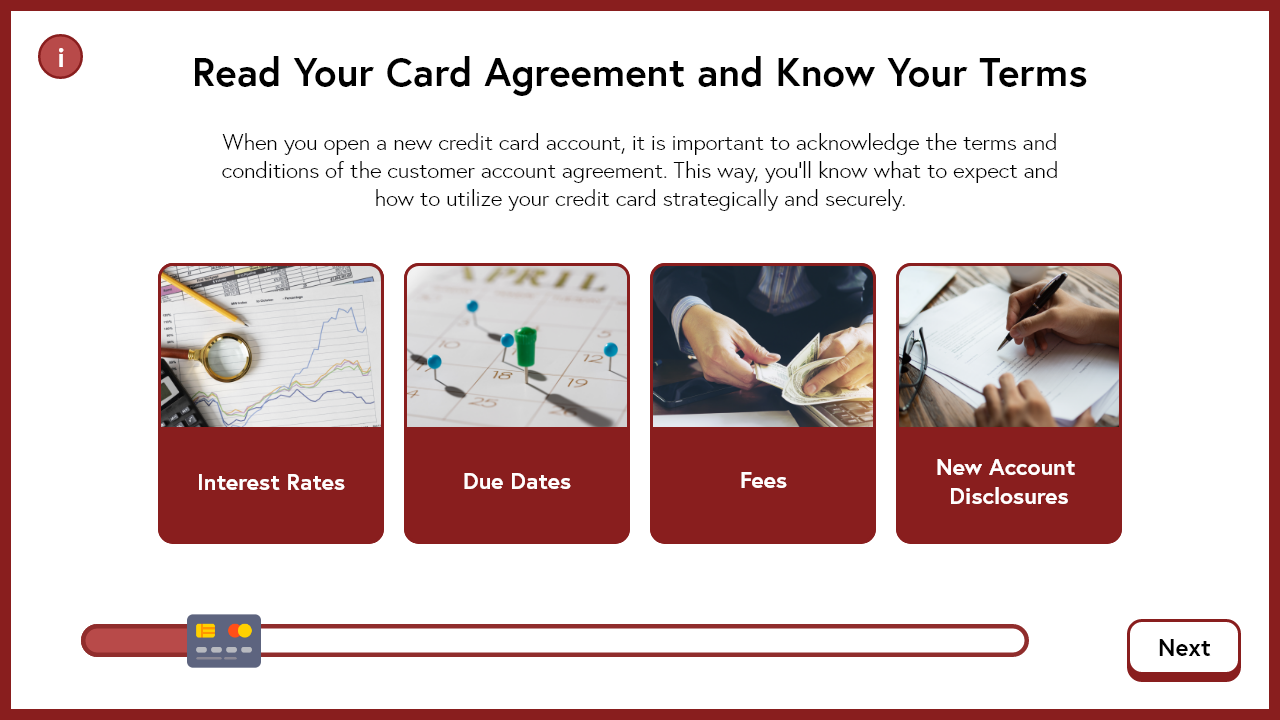Tips for Secure and Effective Credit Card Utilization
Overview
I designed this eLearning project to provide helpful information to current and future credit card users on how to take a more secure and efficient approach to credit card utilization.
Responsibilities: Instructional Design, eLearning Development, Graphic Design, Animation
Target Audience: Current and Future Credit Card Users
Tools Used: Adobe XD, Adobe Illustrator, Storyline 360
Budget: Medium
Year: 2021
The Problem
I designed this project to assist a financial institution in customer acquisition by addressing misunderstandings and misuse concerning credit cards. The client determined that they want their financial institution to provide a helpful deliverable to their current and potential credit card users. The client’s goal was to assist customers in maintaining financial peace by knowing how to apply the best use of their cards.
The Solution
To provide an engaging deliverable that addressed the institution’s particular needs, I proposed an eLearning course built on microlearning principles. I suggested this type of course because credit cards aren’t necessarily an exciting topic of discussion and I think we’ve all seen infomercials and infographics that just aren’t engaging, causing the message to go right over our heads. The client agreed, expressing doubts about people holding interest for long durations of time. Taking this microlearning approach allowed me to incorporate short, interactive formative assessments to evaluate learners’ understanding along the way.
My Process
The client had pre-existing content in the form of an article written by one of their employees. Fortunately, this article was well written with generous detail, and that allowed me to build exclusively from this single resource. I was able to outline, storyboard, and finalize this project in Storyline 360. I also used Adobe Illustrator and XD for visual mockups.
Working with pre-existing content, I analyzed and proposed a variety of solutions that would demonstrate to customers, how to use and manage their credit cards in ways that would benefit them. As a result, I produced a set of measurable learning objectives to employ. These goals served as a guide for my subsequent content design decisions. I then, organized the content to ensure it was logically flowing, simple to understand, and appropriately arranged.
Instructional Design
For this course, I sought to focus on “tricks of the trade” problem-solving strategies that learners can develop through experience to operate effectively in various settings. I employed cognitive management strategies that assisted me in goal setting, strategic planning monitoring, evaluation, and revision. To help learners reconfigure existing knowledge, explore new settings, and become more familiar with presented topics, learners are given the chance to invent, engage in, observe or discover expert strategies through interactive scenarios that systematically encourage student exploration and independence.
Throughout the course, learners are also assisted in their journey by receiving prompts, hints, and feedback; providing scaffolding support for learners as they navigate various micro-lessons that gradually lend more responsibility to the learner. I intentionally sequenced this course by staging the lessons in a way that allows learners to develop a deeper understanding of the complete landscape prior to attending to details. Learners will develop various skills and knowledge required for expert performance while exploring the conditions under which they apply.
This interactive eLearning course reproduces the technological, social, time, and motivational characteristics of real-world situations. Placing content in a context where learners have the opportunity to learn when, where, and how the education applies to specific situations. For example, credit card users must practice safe utilization when making an online purchase. This course allows learners to experience the trials and errors of making an online purchase with considerations of safety and effectiveness.
Visual Mockups
I used Adobe Illustrator and XD to create visual mockups for this project, integrating licensed and custom illustrations to bring my ideas to life. From here I designed various illustrations, a color palette, icons and animations that would get learners visually engaged.
Prototype and Finalization
Once visual mockups were complete, I developed a comprehensive prototype using Storyline 360. The content, arrangement and functionality of the prototype were reviewed and approved by the client. After applying revisions from feedback to the rapid prototype, I finalized product.
Results
This course is featured in welcome emails when customers open or inquire about an account or credit line and is displayed on the company’s website for potential customers to determine whether taking that next step is right for them or not. “Great things do come in small packages!”, says the happy client! This client was particularly pleased with the microlearning principles incorporated in the project. This deliverable yields a seat time of about seven to thirteen minutes (depending on the learner) and is appropriately packed with significant tidbits of information. The client appreciated that this approach allowed learners to gain necessary knowledge without being inundated with filler information.







